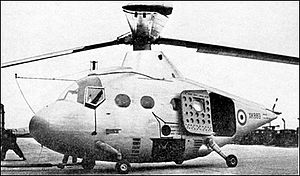Percival P.74 Video - Picture

|
|
Percival P.74

Aircraft Picture - Hunting Percival P.74 being readied for flight testing c. 1956
Role: Helicopter
National origin: United Kingdom
Manufacturer: Percival Aircraft Company
Status: Cancelled 1956
Number built: 1
The Percival P.74 (later Hunting Percival P.74) was a British experimental helicopter designed in the 1950s that was based on the use of tip-jet powered rotors. Although innovative, the tip-rotor concept literally failed to get off the ground in the P.74, doomed by its inadequate power source. Rather than being modified, the P.74 was ignominiously towed off the airfield and scrapped.
Design and development
In 1951, a Helicopter Division was formed by Percival Aircraft Company and design work commenced on a medium-sized helicopter designated P.74. The helicopter was designed to meet Air Ministry Specification EH.125D issued in May 1952 for an experimental helicopter to test jet driven rotors. This experimental helicopter had a teardrop-shaped fuselage with a two-seat cockpit in the nose and a large cabin running the full length of the fuselage. Beneath the cabin floor were two Napier Oryx gas generators which fed compressed air to the tips of the three rotor blades through triple ejector ducts. The rotor blades used ailerons on the trailing edges with pitch control achieved by a screw jack. The unusual engine location necessitated exhaust pipes coming through the cabin wall between the rows of seats, creating an unenviable amount of din and heat for the intended passengers.
The lack of gearbox and simplified coupling of rotor to the aircraft meant that a tilting rotor hub could be used and drag hinges were not needed. The low torque coupling at the mast meant that very little was needed in the form of lateral control. The P.74 rotor was expected to be quieter in operation than tip jets following tests with a Derwent engine powered rotor. The stainless-steel rotors were thick in cross section to allow for the necessary ducting to the tips and non-feathering - as a result ailerons were fitted to the blades.
The P.74 prototype (designated the Hunting Percival P.74 after the company name change was instituted in 1954) was completed in the spring of 1956, and given the military serial number XK889. The final product looked decidedly ungainly with the large bulbous fuselage tapering to a tiny "tailcone" that featured an equally tiny tail rotor (deemed sufficient for control since there was no torque from the tip-rotors). The undercarriage consisted of four wheels on splayed-out stubs with the front two wheels being castoring. The large capacity of the P.74 was to show the possible commercial aspect.
A larger commercial variant, the 10-passenger Percival P.105, with stub wing mounted engines either side of the rotor mast was envisaged and the P.74 was expected to offer information into the necessary ducting required hence the engine was mounted underneath the fuselage with ducts running up through the cabin.
Testing and evaluation

Airplane Picture - Hunting Percival P.74 c. 1956
Ground testing in a static rig commenced in 1956 but the Oryx engines failed to develop full power and maximum gas flow. Even with modifications to the power units, the first flight was aborted when the P.74 failed to fly. This may have been providential as there were no escape provisions for the two pilots. The only entrance door was located at the rear on the port side. The primary test pilot was famously quoted as saying the hapless P.74 had "the cockpit, flying controls and engine controls... designed without any input from a pilot."
It was planned to fit a more powerful Rolls-Royce RB108 turbine and a further development of a ten-passenger (P.105) variant was on the "drawing boards" when the rationalisation of the helicopter industry later that year resulted in the P.74 project being cancelled and the prototype scrapped.
Variants
P.74
Experimental helicopter with a rotor powered by two Napier Oryx gas generators, one built but failed to fly and was scrapped.
P.104
Proposed variant with non-laminar-flow rotor blades, not built.
P.105
Proposed improved variant with the Oryx generators moved above the cabin, not built
P.113
Proposed improved variant of the P.74 with a Rolls-Royce RB108 engine and redesigned rotor system, not built.
Specifications (P.74)
General characteristics
Crew: 2
Capacity: 8 passengers in two rows
Length: ()
Rotor diameter: 53 ft (15.76 m)
Height: ()
Loaded weight: 7,750 lb (3,515 kg)
Max takeoff weight: lb (kg)
Powerplant: 2 x— Napier Oryx NOr. 1 gas generator, 754 "ghp" shp (563 kW) each
Performance
Maximum speed: 110 mph (intended) (177 km/h)
Fairey Rotodyne
Comparable aircraft
Fairey Jet Gyrodyne (jet tipped rotor driven at takeoff and landing only)
Hiller YH-32 Hornet
Fiat 7002
Bibliography
"Hunting Percival P.74: Research Test Vehicle Approaches the Flight Stage: a New Helicopter Philosophy." (PDF) Flight via flightglobal archive, 1955.
Winchester, Jim. The World's Worst Aircraft: From Pioneering Failures to Multimillion Dollar Disasters. London: Amber Books Ltd., 2005. ISBN 1-904687-34-2.
Percival P.74 Pictures
More airplane video.
Source: WikiPedia